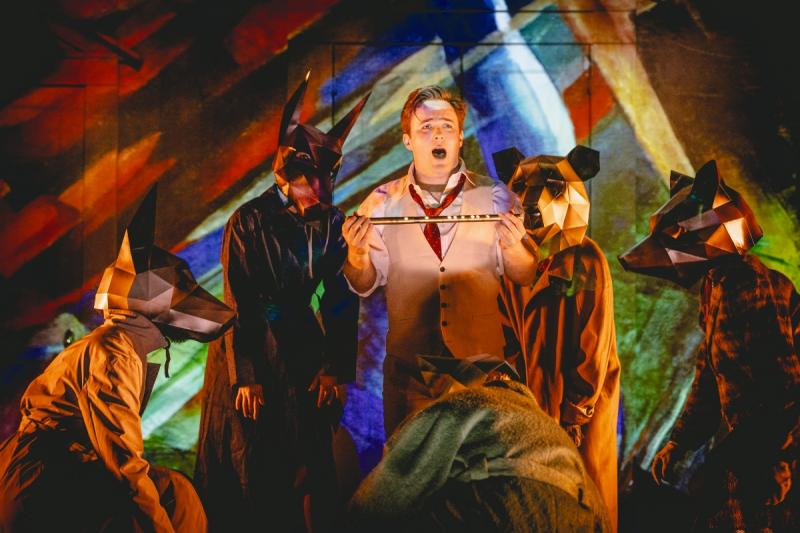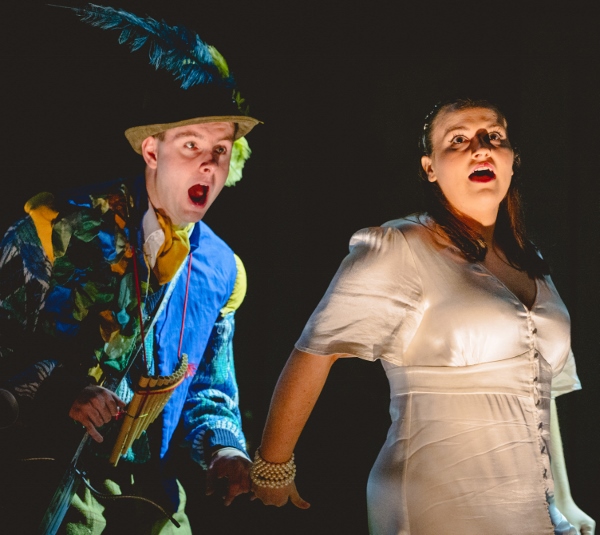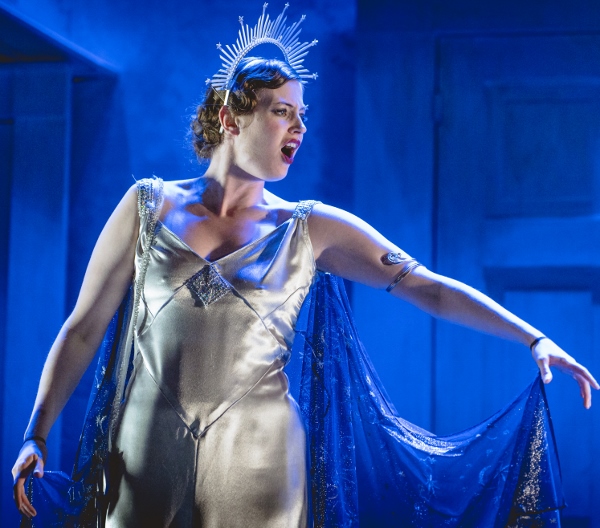The Magic Flute, Clonter Opera review - inventive ideas on the farm | reviews, news & interviews
The Magic Flute, Clonter Opera review - inventive ideas on the farm
The Magic Flute, Clonter Opera review - inventive ideas on the farm
Cheshire platform for emerging talent comes up with the goods again

Necessity has to be the mother of invention for many operatic enterprises these days – and there are few with such inventive powers as those of Clonter Opera in Cheshire.
Its avowed aim is to be a platform for emerging artists and a bridge from conservatoire training to the professional world, and its track record in achieving that for nearly 50 years is impressive. This summer production in the theatre-on-the-farm brought 10 young singers together, bursting with talent, and entertained its audience well.
It has to be inventive, of course. The pit in the Clonter theatre requires reduced orchestrations, and there has to be some doubling of roles, with chorus music sung by all available voices and in this case by using backstage mics at some points.
Director Michael McCaffery, however, has put imagination and invention into every detail of it, not only providing his own new English translation of the text but adapting the piece to the circumstances in some respects: his and designer Jessica Staton’s concept is that we are finding ourselves with a touring troupe of singers in the 1930s who happen upon an empty theatre. The outside world is not a friendly one, but they discover some miscellaneous costumes and some props from a previous production – very handy – and restore their faith in human values by putting on their own The Magic Flute.
Not every detail of the original story has to be explained – and it helps if you know roughly what to expect before it starts – but it was always a theatre people’s show, and these theatre people are faithful to its intentions.
So we have some mime to set that up while the 11-strong Clonter Sinfonia, led by Liz Rossi, plays the overture, and then we’re into the story with little adaptation, and only a few omissions from the score. The Three Boys appear as masks on staves held by cast members, with their music sung from off-stage by the same voices as the Three Ladies, the cast also don animal masks and become Sarastro’s community members where required, and we don’t hear or see the Armed Men.
The important thing here is the quality of the voices and their auspicious prospects for the future. One singer who is well fledged and joined the cast at short notice as Third Lady to cover an indisposition is Sarah Luttrell, already well known in Wexford: her voice quality is a delight and her professionalism showed at every turn.
 Hannah O’Brien – recent RNCM graduate and also a Wexford Opera Factory member – was Pamina and made the role the pivot of the drama as it should be: with Jordan Harding (also ex-RNCM and returning to Clonter for this production) as Papageno, the duet “To long for love is only human” (Bei Männern, welche Liebe fühlen) drew some of the most enthusiastic applause of the first Act (see picture). His acting had the authentic quality of that likeable likely lad first created by Mozart’s collaborator Emanuel Schikaneder, which should be a highly marketable ability. Her phrasing of “Ah, I feel” (Ach, ich fühls) was beautifully poised, with well-centred intonation.
Hannah O’Brien – recent RNCM graduate and also a Wexford Opera Factory member – was Pamina and made the role the pivot of the drama as it should be: with Jordan Harding (also ex-RNCM and returning to Clonter for this production) as Papageno, the duet “To long for love is only human” (Bei Männern, welche Liebe fühlen) drew some of the most enthusiastic applause of the first Act (see picture). His acting had the authentic quality of that likeable likely lad first created by Mozart’s collaborator Emanuel Schikaneder, which should be a highly marketable ability. Her phrasing of “Ah, I feel” (Ach, ich fühls) was beautifully poised, with well-centred intonation.
Naomi Rogers (ex-RNCM) was First Lady and Papagena – distinguished and vocally alive in both – and Laura Fleur was fully effective as Second Lady (and of course contributing in many other respects, as were all the female singers).
 For the Queen of the Night, Clonter has Louisa Stirland (pictured), a soprano with all the notes and impeccable control of them. What more needs to be said? If you can do that, there is little you cannot do (and she can act a mature role effectively). The men made up a strong team, too, with some rich, well moulded tone from Adam Jarman (currently at the RNCM) as the Speaker, and an imposing Irish-accented Sarastro from Fionn Ó hAlmhain (“When in this holy temple” – In diesen Heil’gen Hallen – coming across powerfully).
For the Queen of the Night, Clonter has Louisa Stirland (pictured), a soprano with all the notes and impeccable control of them. What more needs to be said? If you can do that, there is little you cannot do (and she can act a mature role effectively). The men made up a strong team, too, with some rich, well moulded tone from Adam Jarman (currently at the RNCM) as the Speaker, and an imposing Irish-accented Sarastro from Fionn Ó hAlmhain (“When in this holy temple” – In diesen Heil’gen Hallen – coming across powerfully).
Henry Ngan made an attractive near-pantomime baddie of Monastatos – the best thing to do with the role – and displayed an enviable tone quality both while doing it and in the chorus numbers.
And Jack Roberts as Tamino is that rare thing, a tenor of real power and considerable sophistication, with staying power and natural characterization.
The musical quality of the whole enterprise is down to music director and conductor Philip Sunderland, who knows the ideal speeds for every number in the piece and draws the best from all his singers.
Lighting by Pablo Fernandez Baz and the choreography by Steve Elias were both deployed to good effect, but one of the innovations of this production was the use of video projection, for which I take it the credit goes to Steve Brookfield. Both the adornments of the stage set, providing detailed, colourful extra dimensions to the design, and the “silent movie” of Pamina in Act One, were highly effective. They do much work of this kind in more highly subsidized houses nowadays and it’s good to see that Clonter is now up with the best.
- Further performances tomorrow, 27th and 29th July
rating
Explore topics
Share this article
The future of Arts Journalism
You can stop theartsdesk.com closing!
We urgently need financing to survive. Our fundraising drive has thus far raised £49,000 but we need to reach £100,000 or we will be forced to close. Please contribute here: https://gofund.me/c3f6033d
And if you can forward this information to anyone who might assist, we’d be grateful.

Subscribe to theartsdesk.com
Thank you for continuing to read our work on theartsdesk.com. For unlimited access to every article in its entirety, including our archive of more than 15,000 pieces, we're asking for £5 per month or £40 per year. We feel it's a very good deal, and hope you do too.
To take a subscription now simply click here.
And if you're looking for that extra gift for a friend or family member, why not treat them to a theartsdesk.com gift subscription?
more Opera
 Tosca, Welsh National Opera review - a great company reduced to brilliance
The old warhorse made special by the basics
Tosca, Welsh National Opera review - a great company reduced to brilliance
The old warhorse made special by the basics
 BBC Proms: The Marriage of Figaro, Glyndebourne Festival review - merriment and menace
Strong Proms transfer for a robust and affecting show
BBC Proms: The Marriage of Figaro, Glyndebourne Festival review - merriment and menace
Strong Proms transfer for a robust and affecting show
 BBC Proms: Suor Angelica, LSO, Pappano review - earthly passion, heavenly grief
A Sister to remember blesses Puccini's convent tragedy
BBC Proms: Suor Angelica, LSO, Pappano review - earthly passion, heavenly grief
A Sister to remember blesses Puccini's convent tragedy
 Orpheus and Eurydice, Opera Queensland/SCO, Edinburgh International Festival 2025 review - dazzling, but distracting
Eye-popping acrobatics don’t always assist in Gluck’s quest for operatic truth
Orpheus and Eurydice, Opera Queensland/SCO, Edinburgh International Festival 2025 review - dazzling, but distracting
Eye-popping acrobatics don’t always assist in Gluck’s quest for operatic truth
 MARS, Irish National Opera review - silly space oddity with fun stretches
Cast, orchestra and production give Jennifer Walshe’s bold collage their all
MARS, Irish National Opera review - silly space oddity with fun stretches
Cast, orchestra and production give Jennifer Walshe’s bold collage their all
 Káťa Kabanová, Glyndebourne review - emotional concentration in a salle modulable
Janáček superbly done through or in spite of the symbolism
Káťa Kabanová, Glyndebourne review - emotional concentration in a salle modulable
Janáček superbly done through or in spite of the symbolism
 Buxton International Festival 2025 review - a lavish offering of smaller-scale work
Allison Cook stands out in a fascinating integrated double bill of Bernstein and Poulenc
Buxton International Festival 2025 review - a lavish offering of smaller-scale work
Allison Cook stands out in a fascinating integrated double bill of Bernstein and Poulenc
 Tosca, Clonter Opera review - beauty and integrity in miniature
Happy surprises and a convincing interpretation of Puccini for today
Tosca, Clonter Opera review - beauty and integrity in miniature
Happy surprises and a convincing interpretation of Puccini for today
 Hamlet, Buxton International Festival review - how to re-imagine re-imagined Shakespeare
Music comes first in very 19th century, very Romantic, very French operatic creation
Hamlet, Buxton International Festival review - how to re-imagine re-imagined Shakespeare
Music comes first in very 19th century, very Romantic, very French operatic creation
 Falstaff, Glyndebourne review - knockabout and nostalgia in postwar Windsor
A fat knight to remember, and snappy stagecraft, overcome some tedious waits
Falstaff, Glyndebourne review - knockabout and nostalgia in postwar Windsor
A fat knight to remember, and snappy stagecraft, overcome some tedious waits
 Salome, LSO, Pappano, Barbican review - a partnership in a million
Asmik Grigorian is vocal perfection in league with a great conductor and orchestra
Salome, LSO, Pappano, Barbican review - a partnership in a million
Asmik Grigorian is vocal perfection in league with a great conductor and orchestra
 Semele, Royal Opera review - unholy smoke
Style comes and goes in a justifiably dark treatment of Handelian myth
Semele, Royal Opera review - unholy smoke
Style comes and goes in a justifiably dark treatment of Handelian myth

Add comment